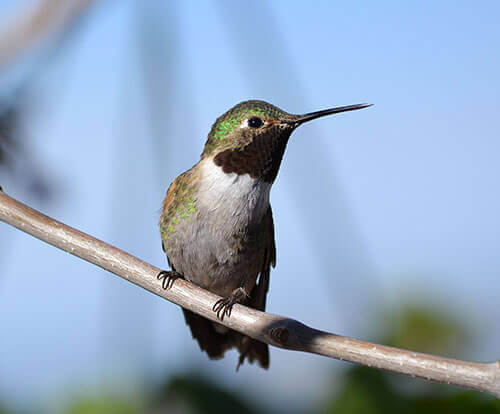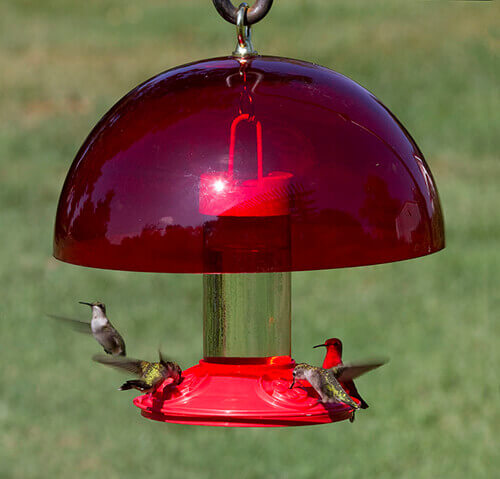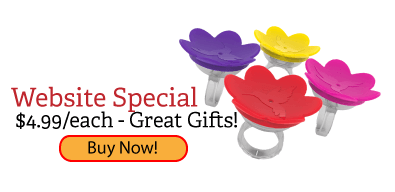Tips for Attracting Hummingbirds
Tips for Attracting Hummingbirds
 In the United States, you can find over 16 kinds of Hummingbirds. For people east of the Rockies, the most prevalent by far is the Ruby-Throated Hummingbird. In fact, the Ruby-Throated Hummingbird is the most widely distributed of the world’s 338 species of Hummingbirds, all of which occur ONLY in the Western Hemisphere. The Ruby-Throated Hummingbird is often found between woodland and meadow; however, it has adapted well to human development, but only if there is shelter, space and food. It is frequently seen in suburban backyards with mature trees and shrubs, in wooded parks, and around farmsteads. The Keys to Attracting Hummingbirds are to provide Food, Help for Nesting, and Misters (Water) for them to fly through. Providing natural plants that bloom from Spring through Fall is one of the best ways to attract hummers to your yard! Read on and learn how to make your yard a “HummingbirdHaveno”
In the United States, you can find over 16 kinds of Hummingbirds. For people east of the Rockies, the most prevalent by far is the Ruby-Throated Hummingbird. In fact, the Ruby-Throated Hummingbird is the most widely distributed of the world’s 338 species of Hummingbirds, all of which occur ONLY in the Western Hemisphere. The Ruby-Throated Hummingbird is often found between woodland and meadow; however, it has adapted well to human development, but only if there is shelter, space and food. It is frequently seen in suburban backyards with mature trees and shrubs, in wooded parks, and around farmsteads. The Keys to Attracting Hummingbirds are to provide Food, Help for Nesting, and Misters (Water) for them to fly through. Providing natural plants that bloom from Spring through Fall is one of the best ways to attract hummers to your yard! Read on and learn how to make your yard a “HummingbirdHaveno”
Feeding Your Hummingbirds
 Hummingbirds are extremely loyal to feeding sites. A Hummingbird that feeds in your yard one year will return to that feeder the next. As the male Ruby-Throated Hummingbird is so territorial, one key is to offer lots of hummingbird feeders. No matter what kind of feeders you decide to use. It is important to keep the feeder clean and the nectar fresh. Hummingbirds keep their distance from fermented nectar. Perhaps Hummers understand that they need a clear head for their acrobatic flying. Fermented nectar can support the growth of deadly molds. A Hummingbird that gets a taste of fermented nectar will look elsewhere and remain suspicious of the offending feeder for a long time.
Hummingbirds are extremely loyal to feeding sites. A Hummingbird that feeds in your yard one year will return to that feeder the next. As the male Ruby-Throated Hummingbird is so territorial, one key is to offer lots of hummingbird feeders. No matter what kind of feeders you decide to use. It is important to keep the feeder clean and the nectar fresh. Hummingbirds keep their distance from fermented nectar. Perhaps Hummers understand that they need a clear head for their acrobatic flying. Fermented nectar can support the growth of deadly molds. A Hummingbird that gets a taste of fermented nectar will look elsewhere and remain suspicious of the offending feeder for a long time.
Keep bees and wasps away from feeders by using a flat top feeder where the nectar is not at the feeding port. Hummers can reach the nectar but wasps and bees can’t! Keep ants away by placing a nectar protector ant moat above the feeder and fill it with water (ants can’t swim!).
Nestingmmer Helper Cage & Nesting Material
A Hummingbird nest is not much bigger than a quarter, and often it contains just 2-3 eggs no bigger than peas. It’s typically hard to see as it blends in to the tree branch it’s attached to. It is made of fine animal or plant down and moss or lichens. Hummingbirds have been proven to really take to a product called “Hummer Helper™” Nesting Material which provides a natural replacement for some hard to find materials.
Fun Hummingbird Facts:
- They can fly at speeds of 60 miles per hour and can fly forwards, backwards, up, down, sideways, and evenupside down briefly, but they can’t walk.
- Their tongues can reach out over 2-3” and can easily be seen in a clear test tube.
- Hummingbirds beat their wings about 78 times per second. During a display dive, their wings can beat up to 200 times per second.
- They take about 250 breaths per minute.
- Their hearts beat about 1,260 times per minute.
- They have 1,500 feathers.
- They consume half their body weight (1/8 lb) in food every day. That would be like an average kid eating about 40 to 50 pounds of food a day.
- During migration they must fly 500 miles nonstop over the Gulf of Mexico to reach their wintering grounds in Mexico and Central America. To make the trip, they must eat enough so they weigh 1 ½ times their usual weight.
- Average life span is 3-5 Years. Maximum 12 Years.
Posted Date: 2019-05-15

